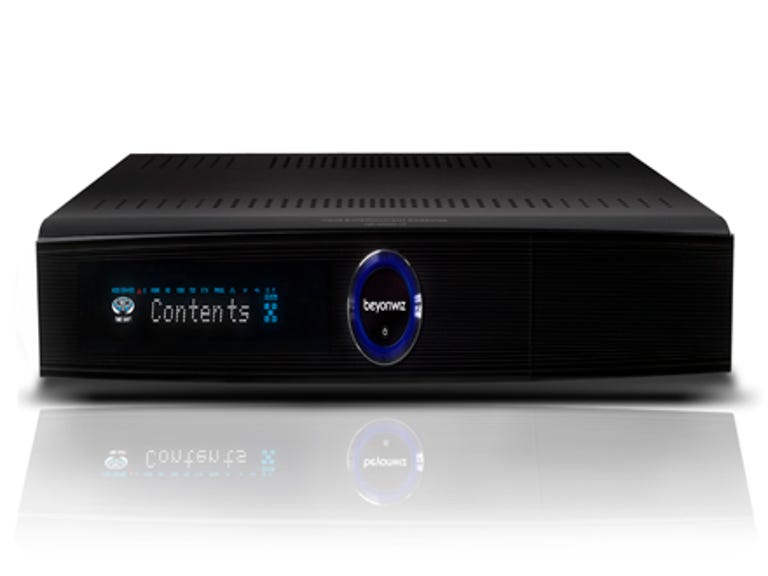 Why You Can Trust CNET
Why You Can Trust CNET Beyonwiz DP-H1 review: Beyonwiz DP-H1
Want a PVR with unlimited storage capability? Beyonwiz's H1 offers exactly that - in a manner of speaking.
Design
Beyonwiz's DP-H1 Set Top Box doesn't quite have the smooth lines of the appealing (but still flawed) DP-S1. Visually, the H1 is virtually identical to the DP-P1, a hard disk enabled PVR that retails for just north of a thousand dollars. The H1 has the same little blue power ring with an LCD display to the right, and like the P1, connections on the back cover all the main AV bases. You do lose the front-mounted USB and flash card ports for your cheaper purchase price, however.
The Good
The Bad
The Bottom Line
Like the P1, the H1's remote can only be called "busy". Or perhaps "confusing" -- while we can usually count on being familiar enough with a remote after a week's worth of solid testing to be able to find features without looking, we always had to peer at the H1's remote to remind ourselves where key features lay.
Features
At its core, the H1 is essentially a high definition digital TV tuner, and we've got to be honest here -- they're no longer quite as exciting as they used to be. Where the H1 makes things interesting is in the inclusion of PVR-style features -- of a sort. The H1 doesn't come with any inbuilt storage for recording TV, fast forwarding or rewinding captured video, or running a proper EPG.
What it does come with, however, is a pair of USB slots. USB slots that can accept any standard USB storage device as though it was an internal hard drive, opening up the kinds of PVR malarkey that bigger, more expensive boxes offer. It's a canny move; while other PVRs (including Beyonwiz's own models) may be hampered by the lack of total storage, with the H1 you can always (in theory) just whack in more storage as and when you need it.
The H1 is also ICEGuide compatible, although again you'll need a connected USB drive to store all the EPG data. It comes with an integrated network port, so EPG updates should flow smoothly after initial setup. Network video, audio and photo playback is also supported from PCs and other Beyonwiz devices.
Performance
As a straight HD STB, the H1 works well, but then most HD STB systems tend to. Setup of the system was mostly painless, although we did find the remote intermittently sluggish for some menu selections. Likewise, configuring ICEguide seemed a little tougher than it should be. You have to first set up your password and user ID on the H1, and then you have to let your ICEguide online account know that you have an H1, and then you can select it from the H1's menu screen, as long as your network is working. For what it's worth, though, at the time of writing, the online ICEGuide service didn't offer the H1 as a choice; we were able to get EPG updates flowing by telling it we had the costlier S1 instead.
The promised USB drive compatibility is a little fiddly as well. You have to register each drive you wish to use, formatting the drives in the process. They're just plain FAT32 formats, however, so it's trivial to hook them up to a PC and download the files. The H1 does use a proprietary format, and we can't tell you how to convert them to other more portable uses, but a quick bit of Googling may indicate methodologies involved, if you know what we mean.
The H1 is meant to be compatible with a wide range of video sources, but we had a decidedly patchy time with many of our test files, and grew far too accustomed to the dreaded "Unsupported Format" message -- even for file formats that the H1 should have been perfectly happy with. Playing back some unsupported files even managed to lock up the H1's user interface, which we were less than thrilled with.
Beyonwiz may be able to make decent looking external enclosures, but they're still badly lacking when it comes to making good looking GUIs -- or even functional ones. As with the S1, we struggled to get network streaming working reliably all of the time, and equally struggled with the pedestrian (and sometimes downright ugly) user interface.
Like other Beyonwiz products, the H1 promises "Internet Features", but fails to deliver them, falling back on promises of future firmware upgrades. We're wary of this kind of thing, as it leaves consumers dangling while they wait for promised features to become a reality -- and by then, the vendor has your money and not much reason to continue investing in older models.
At AU$699, the H1 does come in at a tempting price point, especially if you've already got an external drive or two that you're willing to sacrifice for portability. At the same time, we can't see a point in buying the H1 without an external drive -- and once you factor the price of the drive in, you're getting very close to the price of a built-in model as well. The H1 does represent a step in the right direction for Beyonwiz, but we do wish they'd deliver a model that isn't so reliant on future firmware promises and just worked straight out of the box.


